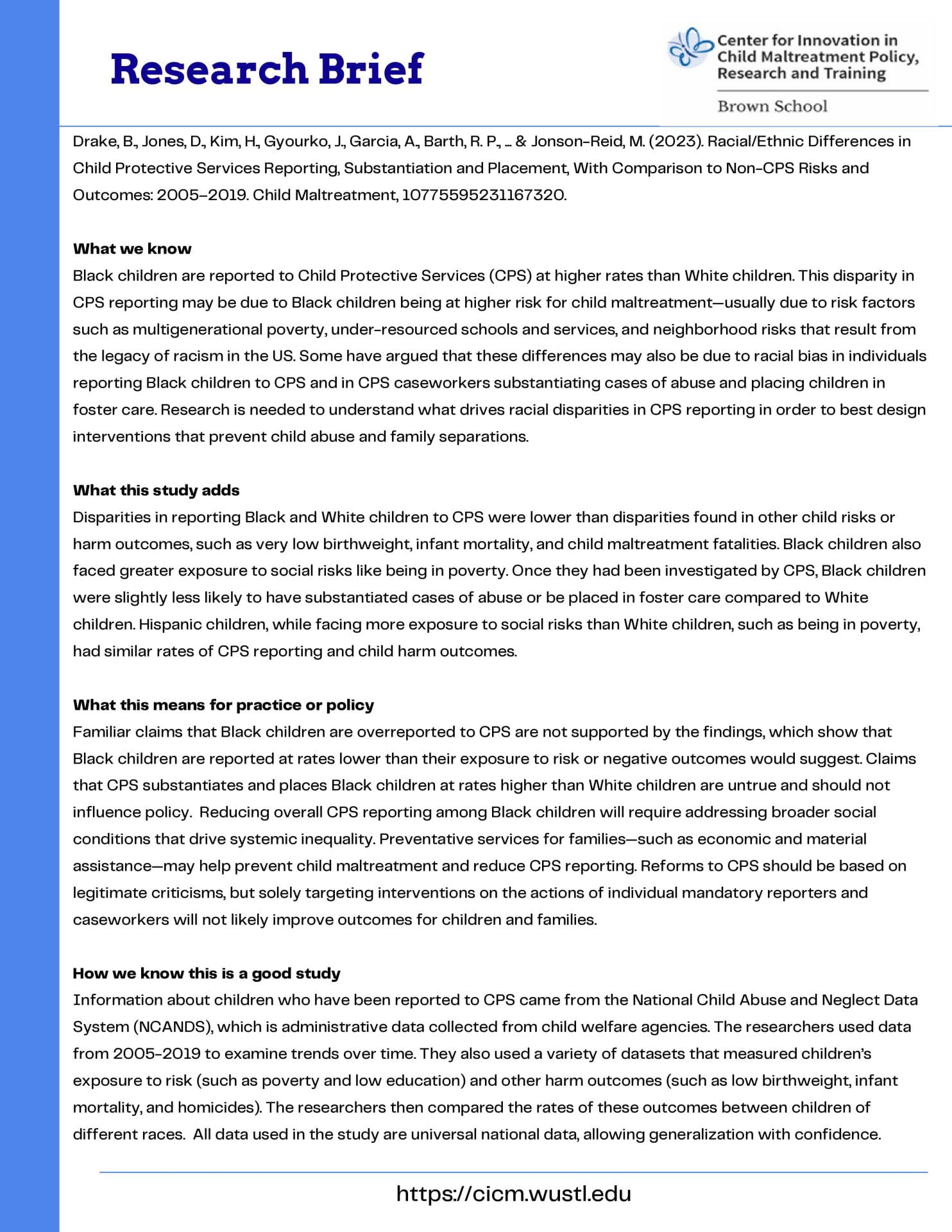Racial/Ethnic Differences in CPS Reporting, Substantiation and Placement, With Comparison to Non-CPS Risks and Outcomes: 2005–2019
Research Brief

Drake, B., Jones, D., Kim, H., Gyourko, J., Garcia, A., Barth, R. P., … & Jonson-Reid, M. (2023). Racial/Ethnic Differences in Child Protective Services Reporting, Substantiation and Placement, With Comparison to Non-CPS Risks and Outcomes: 2005–2019. Child Maltreatment, 10775595231167320
What we know
Black children are reported to Child Protective Services (CPS) at higher rates than White children. This disparity in CPS reporting may be due to Black children being at higher risk for child maltreatment—usually due to risk factors such as multigenerational poverty, under-resourced schools and services, and neighborhood risks that result from the legacy of racism in the US. Some have argued that these differences may also be due to racial bias in individuals reporting Black children to CPS and in CPS caseworkers substantiating cases of abuse and placing children in foster care. Research is needed to understand what drives racial disparities in CPS reporting in order to best design interventions that prevent child abuse and family separations
What this study adds
Disparities in reporting Black and White children to CPS were lower than disparities found in other child risks or harm outcomes, such as very low birthweight, infant mortality, and child maltreatment fatalities. Black children also faced greater exposure to social risks like being in poverty. Once they had been investigated by CPS, Black children were slightly less likely to have substantiated cases of abuse or be placed in foster care compared to White children. Hispanic children, while facing more exposure to social risks than White children, such as being in poverty, had similar rates of CPS reporting and child harm outcomes.
What this means for practice or policy
Familiar claims that Black children are overreported to CPS are not supported by the findings, which show that Black children are reported at rates lower than their exposure to risk or negative outcomes would suggest. Claims that CPS substantiates and places Black children at rates higher than White children are untrue and should not influence policy. Reducing overall CPS reporting among Black children will require addressing broader social conditions that drive systemic inequality. Preventative services for families—such as economic and material assistance—may help prevent child maltreatment and reduce CPS reporting. Reforms to CPS should be based on legitimate criticisms, but solely targeting interventions on the actions of individual mandatory reporters and caseworkers will not likely improve outcomes for children and families.
How we know this is a good study
Information about children who have been reported to CPS came from the National Child Abuse and Neglect Data System (NCANDS), which is administrative data collected from child welfare agencies. The researchers used data from 2005-2019 to examine trends over time. They also used a variety of datasets that measured children’s exposure to risk (such as poverty and low education) and other harm outcomes (such as low birthweight, infant mortality, and homicides). The researchers then compared the rates of these outcomes between children of different races. All data used in the study are universal national data, allowing generalization with confidence.